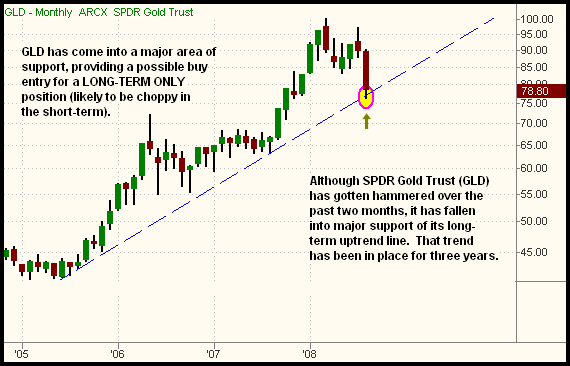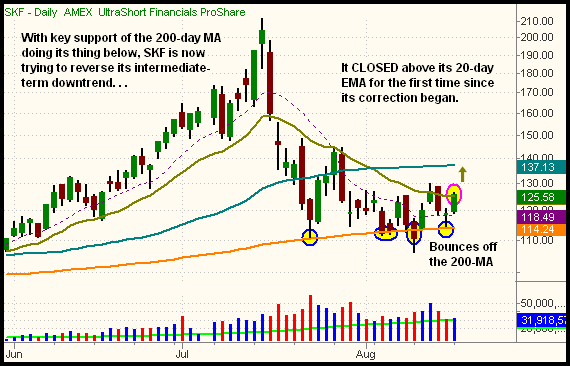|
The Wagner Daily ETF Report For August 19
Key resistance levels for several of the major indices, which we discussed in yesterday's commentary, led stocks to a negative start to the week. After opening slightly higher, the main stock market indexes immediately reversed course and trended steadily lower throughout the entire session. The selling was quite evenly distributed, evidenced by the fact that the S&P 500, Nasdaq Composite, Dow Jones Industrial Average, and small-cap Russell 2000 indices all suffered identical declines of 1.5%. The S&P Midcap 400 lost 1.3%. A small bounce in the final fifteen minutes of trading lifted stocks off their dead lows of the day, but all the major indices still closed in the bottom quarter of their intraday ranges.
Considering the severity of yesterday's broad-based decline, turnover was surprisingly light. Total volume in the NYSE receded 19%, while volume in the Nasdaq came in 6% lower than the previous day's level. Excluding the holiday-shortened session of July 3, volume in both exchanges trickled in at its lowest levels in nearly two months. Lower than average trading is common this time of year, as many investors and traders take their annual vacations in mid-August. The lighter turnover that accompanied yesterday's losses enabled the S&P 500 and Nasdaq Composite to dodge the label of a bearish "distribution day." Nevertheless, recall that "churning" and institutional selling already began presenting itself last week. This is a good example of how volume is typically a leading indicator to price action.
If you've made only the slightest observations of sector performance over the past two months, you already know that commodities have been getting absolutely obliterated. Spot gold is no exception, and its daily chart now looks atrocious. But upon studying the longer-term trends of various commodities last week, we noticed that gold had come into major support of its long-term, multi-year uptrend line. This is illustrated below on the monthly chart of SPDR Gold Trust (GLD), a common ETF proxy that mirrors the price of the spot gold commodity:

As you can see, gold has fallen into support of its long-term uptrend line that began with the low of June 2005. Because the existing trend has already been in place for more than three years, it won't be easy for gold to break down below that trendline without at least putting up a fight. Technical analysis dictates that the longer a trend has been in place, the more likely the price will continue in the dominant direction of that trend. Although not shown on the chart above, GLD has also come into support of its 61.8% Fibonacci retracement from the August 2007 low to the March 2008 high. The 61.8% Fib retracement is considered a "last line of defense" that can still cause a dominant trend to resume.
So, are we bullish on gold, despite the pounding it has taken? The answer depends on the timeframe. In the short to intermediate-term, gold is likely to just chop around in a whippy range. Therefore, we would not try to pick a bottom for only a quick bounce. But if you've been looking for a low-risk place to buy some gold for your long-term account, such as an IRA or 401k, an entry into GLD at current levels makes sense. Alternatively, you might consider the leveraged Gold Double Long ETN (DGP), which roughly moves at double the percentage gain or loss of spot gold. If buying either ETF, don't forget your protective stop, just in case the multi-year uptrend happens to end right here. A stop just below last week's low of $76.61 for GLD, or $15.45 for DGP, including a bit of "wiggle room," makes sense.
In yesterday morning's Market Plot, we analyzed the technical state of the broad market. Specifically, we illustrated how the leading Russell 2000 had run into resistance of its June 2008 high, while the Nasdaq Composite had rallied into resistance of its weekly downtrend line that began last October. The laggard S&P 500 and Dow Jones Industrial Average, we stated, had not yet convincingly cleared resistance of their 50-day moving averages. Overall, we suggested this combination of pivotal resistance levels would likely put pressure on the stock market in the near-term, and that it would be a good idea to start balancing your ETF portfolio with a short position or two. Fortunately, we heeded our own advice by buying the inversely correlated UltraShort Dow 30 ProShares (DXD) when the Dow index broke down below its 50-day MA, shortly after yesterday's open.
In addition to that new short entry of the Dow, we also continue to hold our bearish position in the financials, which we entered last week. As financials have begun to show weakness again, the UltraShort Financials ProShares (SKF) now looks ready to make a significant move higher. Yesterday, it closed above resistance of its 20-day EMA for the first time since mid-July, when the beaten-down sector began its counter-trend bounce off their lows. On the daily chart below, notice how SKF has touched its 20-day EMA (the beige line) on an intraday basis, several times over the past month, but yesterday was the first time it closed above its 20-day EMA (albeit barely):

Our ETF portfolio now consists of two bullish positions (both healthcare ETFs) and two bearish positions (SKF and DXD). The healthcare ETFs corrected along with the rest of the market yesterday, but their chart patterns still look solid. No need to bail out on the strongest sector in the market just yet. But if the broad market continues lower and even healthcare sustains a big drawdown, profits from our SKF and DXD positions should more than make up for the surrendered unrealized gains in the healthcare ETFs. Keep a close eye on yesterday's lows in the S&P 500 and Dow Jones Industrial Average, as a break below those levels would correlate to a confirmed break of their intermediate-term uptrend lines off their mid-July lows.
Deron Wagner is the Founder and Head Trader of both Morpheus Capital LP, a U.S. hedge fund, and Morpheus Trading Group, a trader education firm launched in 2001 that provides daily technical analysis of the leading ETFs and stocks. For a free trial to the full version of The Wagner Daily or to learn about Wagner's other services, visit MorpheusTrading.com or send an e-mail to deron@morpheustrading.com.
|